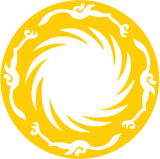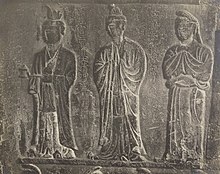Sichuanese people
 The Golden Sun Bird, a relic from the Bashu culture of incredible cultural significance, a totem of the ancient Shu people,[1] and the emblem of Chengdu.[2] | |
| Regions with significant populations | |
|---|---|
| Sichuan Chongqing | |
| As part of Mainlander population | |
| Languages | |
| Historically Ba-Shu Chinese, also known as Old Sichuanese. Presently Sichuanese dialects of Southwestern Mandarin. | |
| Religion | |
| Mahayana Buddhism, Taoism, Confucianism, and Chinese folk religion | |
| Related ethnic groups | |
| other Han Chinese, Yi people, Tujia people, Dai people, Qiang people | |
The Sichuanese, Sze Chuan or Ssu Ch῾uan (previous romanize spelling) people (Sichuanese: 巴蜀人 Ba1su2ren2; IPA: [pa55su21zən21]; alternatively 川人, 川渝人, 四川人 or 巴蜀民系) are any native ethnic group living in mostly Sichuan province and Chongqing municipality of China (100 Million[citation needed]).
History
Beginning from the 9th century BC, Shu (on the Chengdu Plain) and Ba (which had its first capital at Enshi City in Hubei and controlled part of the Han Valley) emerged as cultural and administrative centers where two rival kingdoms were established. Although eventually the Qin dynasty destroyed the kingdoms of Shu and Ba, the Qin government accelerated the technological and agricultural advancements of Sichuan making it comparable to that of the Yellow River Valley. The now-extinct Ba-Shu language was derived from Qin-era settlers and represents the earliest documented division from Middle Chinese.
Most of central Sichuan was inhabited by the Dai people who formed the serfs class, accounting for the vast majority of the population. They were later thoroughly sinicized, adopting the local language of speech. Large numbers of foreigner merchant families from Sogdia, Iran and other countries immigrated to Sichuan.
During the Yuan and Ming dynasties, the population of Sichuan, Chongqing had been reduced due to immigration, deportation and flight of refugees fleeing war and plague, new or returning settlers from modern Hunan, Hubei, Guangdong and Jiangxi, replacing the earlier spoken language with different languages they adopted from the former regions to form a new standard language off communication.[3][4][5]
Recent history
Many migrant workers from rural Sichuan have migrated to other parts of the country, where they often face discrimination in employment, housing etc.[6] This is due to China's household registration policy and other parts of people from midwest China face the same problem.
Language

The Sichuanese once spoke their own variety of spoken Chinese called Ba-Shu Chinese, or Old Sichuanese before it became extinct during the Ming dynasty. Now most of them speak Sichuanese Mandarin. The Minjiang dialects are thought by some linguists to be a bona fide descendant of Old Sichuanese due to many characteristics of Ba-Shu Chinese phonology and vocabulary being found in the dialects,[7] but there is no conclusive evidence whether Minjiang dialects are derived from Old Sichuanese or Southwestern Mandarin.
Cuisine
Sichuan is well known for its spicy cuisine and use of Sichuan peppers due to its more arid climate.
Genetics
DNA research has shown that Sichuanese people are closely genetically related to the Dai people.[8][dubious – discuss]
Notable people
Well known Sichuanese people are such as:
- Chen Shou, official and writer
- Huang Jiguang, highly decorated soldier during the Korean War
- Zhao Yiman, resistance fighter
- Liu Yonghao, businessman
- GAI, rapper, singer, and songwriter
- Zhang Yong (restaurateur), Singapore's richest man in 2019
- Wang Jianlin, business magnate, investor, and philanthropist
- Jiang Zhuyun, revolutionary martyr
- Zhang Daqian, artists
- Wang Xiaoya, television host and media personality
- Li Yifeng, actor and singer
- Li Yuchun, singer, songwriter, and actress
- Tan Weiwei, singer and actress
- Tang Chun-i, philosopher and scholar
- Luo Ruiqing, army officer and politician
- Su Shi, writer, poet, painter, calligrapher, pharmacologist, gastronome, and statesman
- Su Xun, writer
- Su Zhe, politician and essayist
- Li Bai, poet
- Zhuo Wenjun, poet
- Yang Xiong, poet, philosopher, and politician
- Zheng Ji, nutritionist and pioneering biochemist
- Deng Xiaoping, revolutionary and politician
- Ba Jin, author and political activist
- Zhu De, general, warlord, politician, and revolutionary
- Zhang Lan, political activist
- Zou Rong, revolutionary martyr
- Guo Moruo, author, poet, historian, archaeologist, and government official
- Zhang Qun, premier of the Republic of China
- Bai Ling, actress
- Xu Youyu, scholar
- Cheung Chung-kiu, business magnate
- Song Yonghua, scholar
- Sanyu (painter)
References
- ^ Li, Hsing-jung; Fêng, Ming-i; Yü, Chih-yung (1 November 2014). 導遊實訓課程 (in Chinese (Taiwan)). Taipei: E-culture. p. 331. ISBN 9789865650346.
- ^ Agafonov, Arthur; Rasskazova, Elena (2 June 2019). "Homeland of Pepper and Panda: Yin and Yang of the Chinese Hinterland". eastrussia.ru. Retrieved 12 May 2020.
- ^ James B. Parsons (1957). "The Culmination of a Chinese Peasant Rebellion: Chang Hsien-chung in Szechwan, 1644–46". The Journal of Asian Studies. 16 (3): 387–400. doi:10.2307/2941233. JSTOR 2941233.
- ^ Yingcong Dai (2009). The Sichuan Frontier and Tibet: Imperial Strategy in the Early Qing. University of Washington Press. pp. 16–. ISBN 978-0-295-98952-5.
- ^ Entenmann, Robert Eric (1982). Migration and settlement in Sichuan, 1644-1796. Harvard University.
- ^ Handbook of Chinese Migration: Identity and Wellbeing
- ^ 试论宋代巴蜀方言与现代四川方言的关系》">刘晓南(2009年第8卷第6期),《试论宋代巴蜀方言与现代四川方言的关系——兼谈文献考证的一个重要功用:追寻失落的方言》,语言科学
- ^ Gan, R. J., Pan, S. L., Mustavich, L. F., Qin, Z. D., Cai, X. Y., Qian, J., ... & Jin, L. (2008). Pinghua population as an exception of Han Chinese’s coherent genetic structure. Journal of human genetics, 53(4), 303-313.


